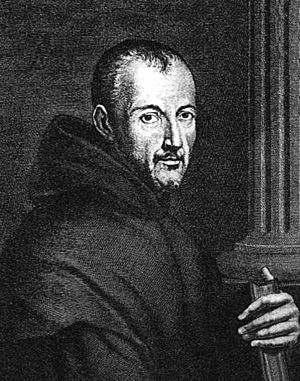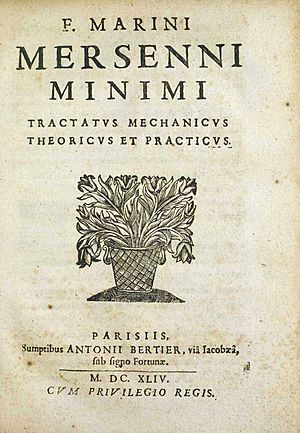Marin Mersenne facts for kids
Quick facts for kids
Marin Mersenne
|
|
|---|---|
 |
|
| Born | 8 September 1588 |
| Died | 1 September 1648 (aged 59) Paris, France
|
| Nationality | French |
| Other names | Marinus Mersennus |
| Known for | Mersenne primes Marsenne's conjecture Mersenne's laws Acoustics |
| Scientific career | |
| Fields | Mathematics, physics |
| Influences | René Descartes Étienne Pascal Pierre Petit Gilles de Roberval Thomas Hobbes Nicolas-Claude Fabri de Peiresc Giovanni Doni Jacques Alexandre Le Tenneur Constantijn Huygens Galileo Galilei |
Marin Mersenne (born September 8, 1588 – died September 1, 1648) was a French scholar who studied many different subjects. He was also known as Marinus Mersennus. Today, mathematicians remember him for Mersenne prime numbers. These are special numbers that can be written as 2 to the power of n, minus 1 (like 23 - 1 = 7).
Mersenne also created Mersenne's laws. These laws explain how strings vibrate to make sounds, like on a guitar or piano. His important book on music theory, Harmonie universelle, led to him being called the "father of acoustics" (the science of sound).
Marin Mersenne was a Catholic priest and a member of the Minim religious order. He had many friends in the science world. People called him "the center of the world of science and mathematics during the first half of the 1600s." He was also known as "the post-box of Europe" because he connected many thinkers. He wrote and taught about theology (religion) and philosophy (ideas about life).
Contents
Life of Marin Mersenne
Mersenne was born in a small village near Oizé, France. His parents, Jeanne Moulière and Julien Mersenne, were farmers. He went to school in Le Mans and then to the Jesuit College of La Flèche.
On July 17, 1611, he joined the Minim Friars. After studying religion and Hebrew in Paris, he became a priest in 1613.
From 1614 to 1618, he taught religion and philosophy in Nevers. In 1620, he moved back to Paris. There, he studied math and music. He met many other smart people, including René Descartes, Étienne Pascal, and Thomas Hobbes.
He also wrote letters to scholars in Italy, England, and the Dutch Republic. These included Galileo Galilei and Constantijn Huygens. Mersenne strongly supported Galileo and helped translate some of his works.
For four years, Mersenne focused on writing about philosophy and religion. He published books like Quaestiones celeberrimae in Genesim (1623) and La Vérité des sciences (1624). He was taught by Jesuits, but he was never a Jesuit himself.
Connecting Scientists
In 1635, Mersenne started an informal group called the Académie Parisienne. This group had almost 140 people who wrote to each other. They included astronomers, philosophers, and mathematicians. This group was a very early version of the French Academy of Sciences.
Mersenne liked to encourage debates among his friends. This helped them compare their ideas. He helped connect many important thinkers of his time. Historians say that groups like the Académie des Sciences in Paris were directly inspired by Mersenne's work.
Mersenne traveled to Italy several times. He corresponded with many scientists, including Descartes, Galileo, and Pascal. He died on September 1, 1648, from a lung problem.
Mersenne's Important Work
Mersenne's book Quaestiones celeberrimae in Genesim was a commentary on the Book of Genesis. In this book, he argued against ideas like magic, fortune-telling, and astrology. He believed these ideas were wrong. He also criticized people who claimed special powers for images or symbols.
Understanding Music and Sound
Harmonie universelle is one of Mersenne's most important works. It is one of the first complete books on music theory. It talks about many musical ideas, especially the math behind music.
This book contains Mersenne's laws, which describe how a stretched string vibrates. The laws state:
- The frequency (how fast it vibrates) is less if the string is longer.
- The frequency is more if the string is pulled tighter.
- The frequency is less if the string is heavier for its length.
The formula for the lowest frequency of a vibrating string is:
where f is the frequency (how many vibrations per second), L is the length of the string, F is the force pulling the string, and μ is the mass of the string per unit length.
In this book, Mersenne also had new ideas for building reflecting telescopes. He thought of using two mirrors, one curved inward and one curved outward. He also realized that he could fix blurry images by using special curved mirrors. However, he never built a telescope himself because of criticism from others, like Descartes.
Mersenne Primes and Beyond
Mersenne is still remembered today because of Mersenne prime numbers. These numbers are used in computer science and cryptography (making and breaking codes). For example, the Mersenne Twister is a widely used tool in computer programming.
Mersenne was not only a mathematician. He also wrote about music and other topics. He edited works by famous Greek mathematicians like Euclid and Archimedes. His most important contribution was his huge network of letters with scientists in many countries. Before scientific journals existed, Mersenne was like a central hub for sharing new ideas.
He also strongly supported the philosopher René Descartes. Mersenne helped share Descartes' ideas in Paris and defended them against critics.
Later in his life, Mersenne focused more on science, especially math, physics, and astronomy. His book Harmonie universelle (1636) is still a key source of information about 17th-century music.
Mersenne also did experiments to measure how fast objects fall. He compared them to the swing of pendulums. He was the first to measure the length of a seconds pendulum (a pendulum that swings once per second). He also noticed that large swings of a pendulum take longer than small swings, which was different from what Galileo thought.
Fighting Against Old Ideas
In the early 1600s, some pamphlets spread around Europe. They talked about a secret group called the Rosicrucians. These pamphlets promoted old ideas about magic and hidden knowledge.
Mersenne strongly fought against these ideas. He argued against people like Robert Fludd, who supported the Rosicrucians. While many people believed in these groups, historians now agree that there was no real Rosicrucian order at that time.
By the mid-1630s, Mersenne believed that true physics should only describe how things move. He rejected older ideas about "essences" (the hidden nature of things). This new way of thinking was inspired by Galileo Galilei. Mersenne had often written to Galileo and continued his work on vibrating strings.
List of Works
- Euclidis elementorum libri, etc. (Paris, 1626)
- Les Mécaniques de Galilée (Paris, 1634)
- Questions inouies ou récréation des savants (1634)
- Questions théologiques, physiques, etc. (1634)
- Harmonie universelle First edition online from Gallica (Paris, 1636)
- Nouvelles découvertes de Galilée (1639)
- Cogitata physico-mathematica (1644)
- Universae geometriae synopsis (1644)
- (in la) Tractatus mechanicus theoricus et practicus. Paris: Antoine Bertier. 1644. https://gutenberg.beic.it/webclient/DeliveryManager?pid=8719810.
See also
 In Spanish: Marin Mersenne para niños
In Spanish: Marin Mersenne para niños
- Cassegrain reflector
- Equal temperament
- List of Roman Catholic scientist-clerics
- Seconds pendulum



